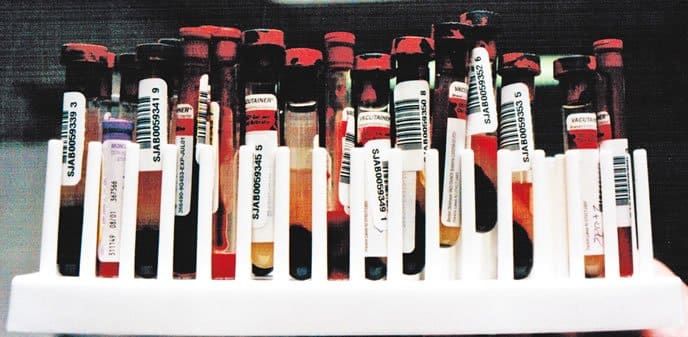Here are some of the values you might find on your dog’s chemistry panel, or “chem screen,” and what they may indicate.

Albumin (ALB)
Low levels of this liver-produced protein can point to chronic liver or kidney disorders, gastrointestinal problems such as inflammatory bowel disease or parasitic infection. Elevated values can mean dehydration.
Alanine aminotransferase (ALT)
The level of this enzyme often rises when the dog has liver and bile-duct disease.
Alkaline Phosphatase (ALKP)
Produced by the liver, this enzyme can be elevated as a result of liver disease, Cushing’s syndrome or steroid therapy. Mildly elevated levels can be normal in puppies.
Amylase (AMYL)
The pancreas produces this enzyme to help in digestion. High levels can indicate pancreatitis, or inflammation of the pancreas.
Blood Urea Nitrogen (BUN)
Urea nitrogen is a waste product created by the liver and excreted by the kidneys. High levels might indicate kidney abnormalities or dehydration, while low levels can signal liver disease. Often compared with creatinine levels (see below).
Calcium (Ca+2)
Increased levels of this mineral can signal disease of the parathyroid or kidney, or certain kinds of tumors.
Cholesterol (CHOL)
Elevated levels of cholesterol can be symptomatic of a number of disorders, including hypothyroidism and liver and kidney disease.
Creatinine (CREA)
Like BUN, with which it is often assessed, creatinine is excreted by the kidneys. High levels can point to dehydration, kidney disease, or obstruction of the urinary tract.
Blood Glucose (GLU)
High levels can mean a dog is simply stressed, but they can also be a symptom of diabetes. Low levels can be an indicator of hypoglycemia, liver disease, and some types of tumors.
Lipase (LIP)
Released by the pancreas into the small intestine, this enzyme helps the body absorb fat. Elevated levels can indicate problems with the pancreas, liver or kidneys, as well as digestive-tract obstructions.
Phosphorus (PHOS)
Most of a dog’s phosphorus stores are in her bones, but a small amount circulates in the blood. High levels can indicate kidney failure, or the ingestion of a toxin like antifreeze.
Total Bilirubin (TBIL)
Secreted by the liver into the intestinal tract, bilirubin is responsible for the yellow color found in bruises, urine and, and its name suggests, bile. Abnormally high levels can mean liver disease or bile-duct problems, and help diagnose anemia.
Total Protein (TP)
Another value that can point to several issues if elevated, including dehydration or diseases of the liver, kidney or intestines.
Electrolytes (Sodium, Potassium, Chloride)
These electrically charged minerals in your body are involved in regulating many important processes, including blood acidity (pH), muscle function and body hydration. Because electrolytes are so integral to cell function, imbalances can be life threatening.
Electrolyte tests are important in evaluating vomiting, diarrhea, dehydration, and cardiac symptoms, and they can tell a vet what kinds of fluids to use with a sick patient, and if any kind of electrolyte supplementation is needed. They can also add important diagnostic clues for some chronic diseases: For example, dogs with Addison’s syndrome (hypoadrenocortism) often have low sodium levels (hyponatremia).
Gamma Globulin
Immune gamma globulins, also called immunoglobins, are antibodies that help fight bacterial and viral infections, cancer or parasites. Elevated levels can indicate that the body is mounting such a defense, while low levels could reflect a compromised immune system.
T4, FT4 and TgAA
The T4 test measures the levels of circulating thyroid hormone in the body. For a true picture of thyroid function, however, FreeT4 (which measures the amount of T4 available to cells and tissues) and TgAA (thyroglobulin autoantibodies, high levels of which can mean immune-mediated thyroid disease) should be run. Dr. Dodds calls T4 by itself “basically useless.”







What is a nsaid panel ordered for healthy eight year old Aussie